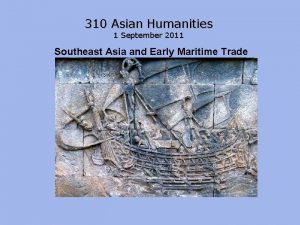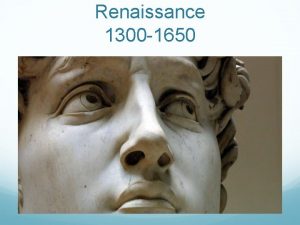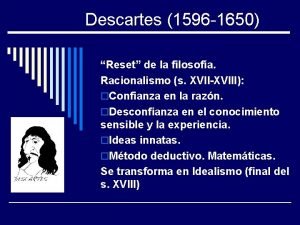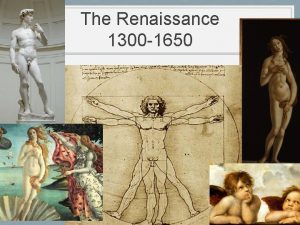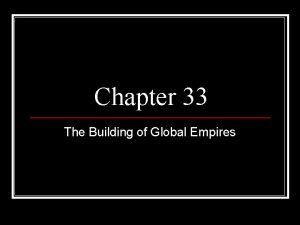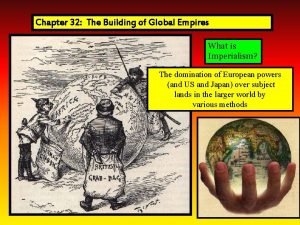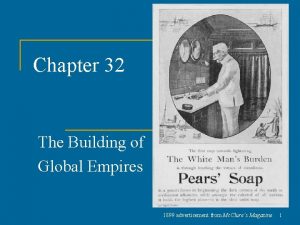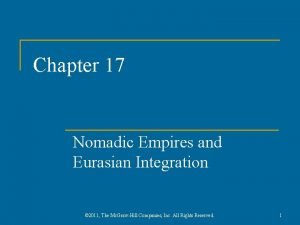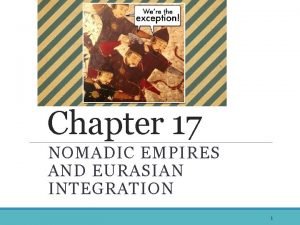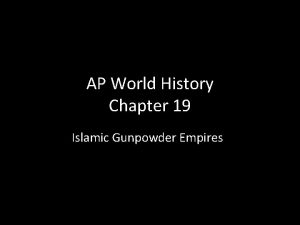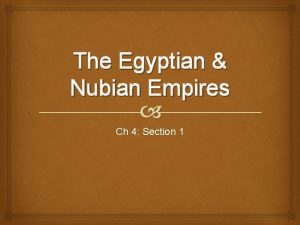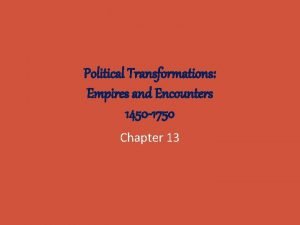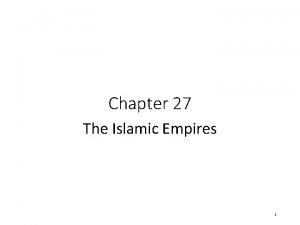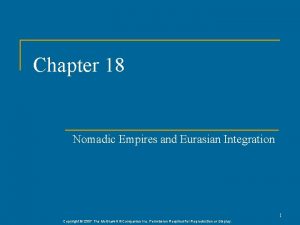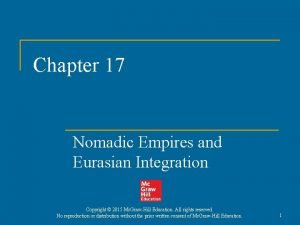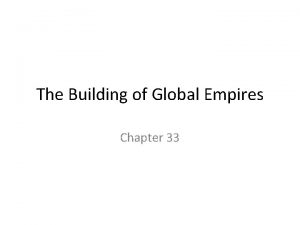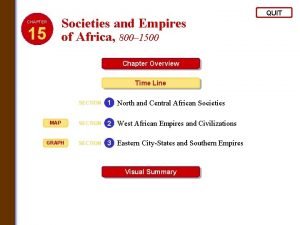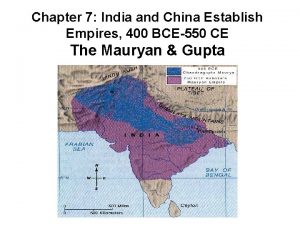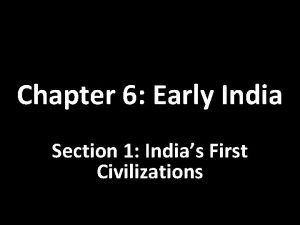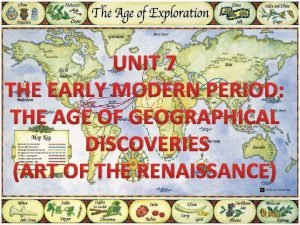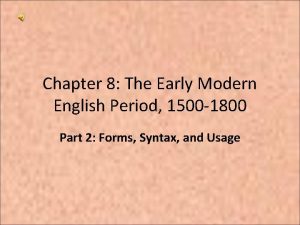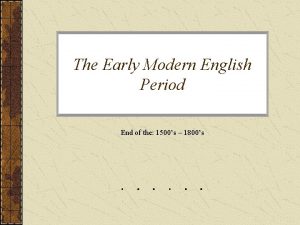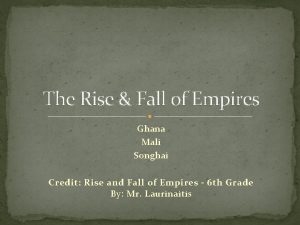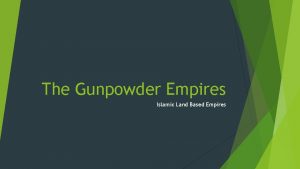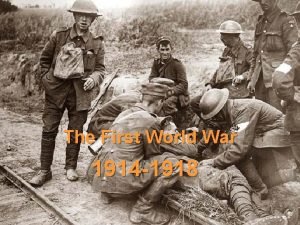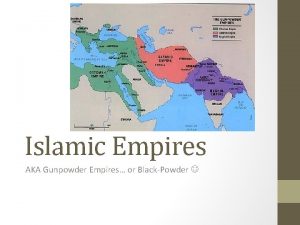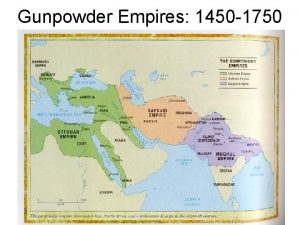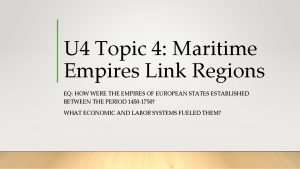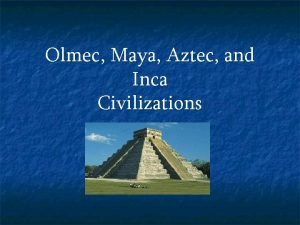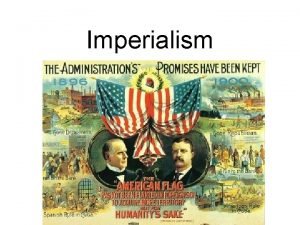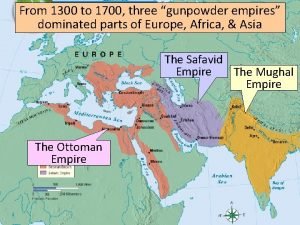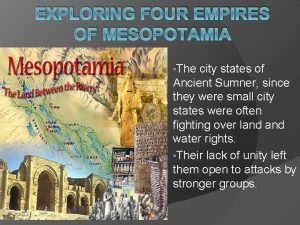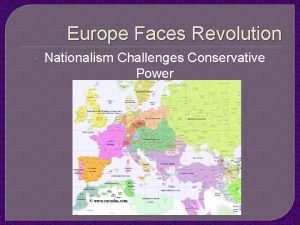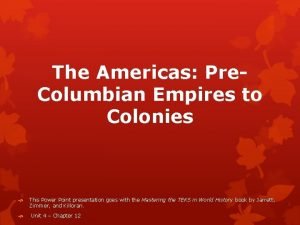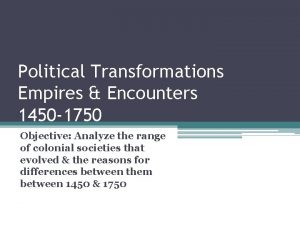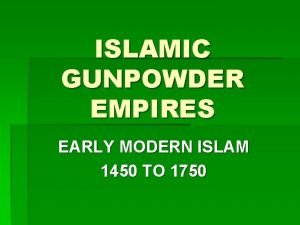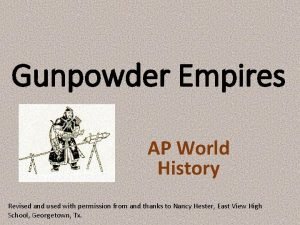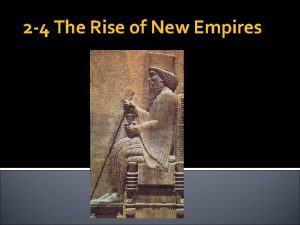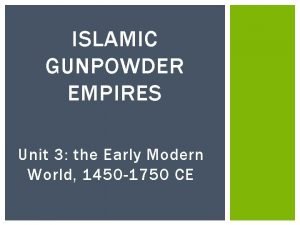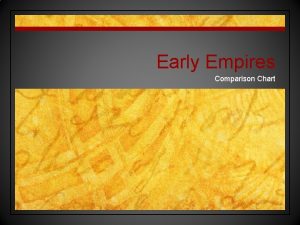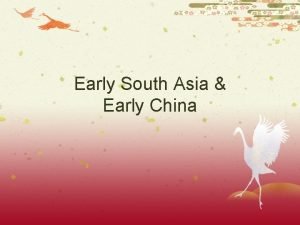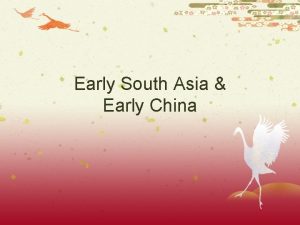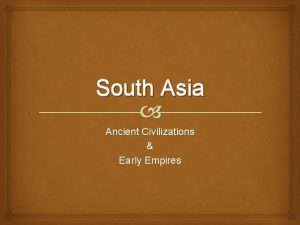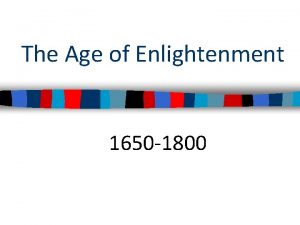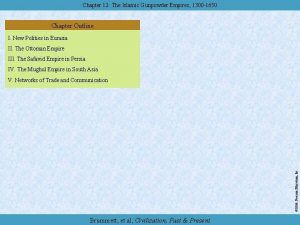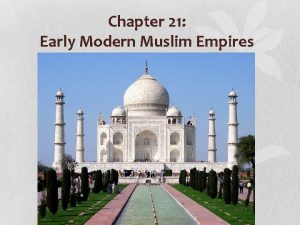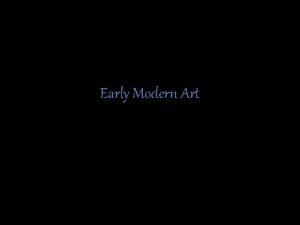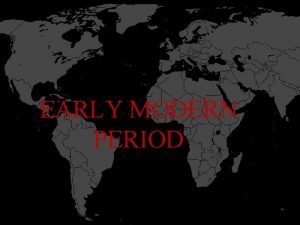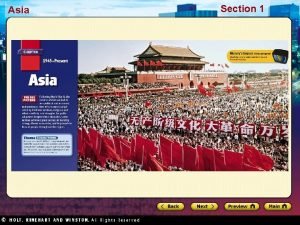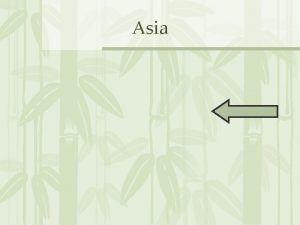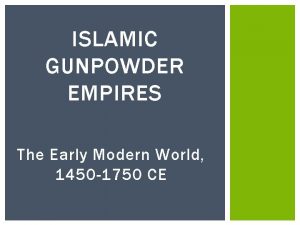Chapter 20 Empires in Early Modern Asia 1650























































- Slides: 55

Chapter 20 Empires in Early Modern Asia, 1650 – 1837 Copyright © 2017 Cengage Learning. All Rights Reserved.

Learning Objectives (Slide 1 of 5) ▪ ▪ Recognize the importance of Rammohun Roy, who became a leader of the Bengal resistance and advocate for reformed Hinduism Describe how the Manchus took over Ming China and formed a Ming-Manchu government under the Qing emperors Copyright © 2017 Cengage Learning. All Rights Reserved.

Learning Objectives (Slide 2 of 5) ▪ ▪ Explain how Qing emperors built and maintained their empire in East and Central China Discuss the nature of women’s lives in Qing China Debate Qing strategies for expansion and its treatment of other people and countries in its path Analyze the Qing’s foreign relations and trade with European powers Copyright © 2017 Cengage Learning. All Rights Reserved.

Learning Objectives (Slide 3 of 5) ▪ ▪ ▪ Identify the factors that drove Russian imperial expansion in the eighteenth century Explain how Catherine the Great used her power to control Russian nobles and the Russian Orthodox Church Summarize Aurangzeb’s role in promoting the stability of the Mughal state Copyright © 2017 Cengage Learning. All Rights Reserved.

Learning Objectives (Slide 4 of 5) ▪ ▪ ▪ Discuss the causes of the decline of Mughal power and how the British replaced the Mughals as the dominant power in South Asia Describe the religious and social changes in India that coincided with the arrival of the British Outline the distinctive features of early modern Japanese history Copyright © 2017 Cengage Learning. All Rights Reserved.

Learning Objectives (Slide 5 of 5) ▪ ▪ ▪ Identify the peak period and features of growth and stability in Tokugawa Japan Compare Tokugawa Japan to the other land-based empires of East Asia in the seventeenth century Summarize the economic changes that occurred in Tokugawa Japan and how these led to social change Copyright © 2017 Cengage Learning. All Rights Reserved.

Rammohun Roy During the lifetime of Rammohun Roy (1772– 1833), South Asia was in transition from Mughal to British rule, and Roy’s repertoire of languages reflected the cultural and religious diversity of his environment. Navigating such diversity, Rammohun Roy became a leading figure of the Bengal Renaissance, a rich intellectual encounter between varied spiritual and cultural traditions. Copyright © 2017 Cengage Learning. All Rights Reserved.

The Travels of Rammohun Roy Copyright © 2017 Cengage Learning. All Rights Reserved.

The Power of the Qing Dynasty, 1644– 1796 (Slide 1 of 2) ▪ Establishment of the Qing rule, 1636– 1661 ▪ Nomadic Manchu originated in the steppes northeast of China ▪ ▪ ▪ By the sixteenth century, some Manchu had taken up agriculture Ming leaders of China bestowed favors upon Manchu adopted Chinese imperial-style government Manchu Language and Culture Copyright © 2017 Cengage Learning. All Rights Reserved.

The Power of the Qing Dynasty, 1644– 1796 (Slide 2 of 2) ▪ In the 1590 s, the Ming called on Manchu armies to repel a Japanese invasion ▪ ▪ Qing / Manchu princess Flower. Pot shoes ▪ ▪ Manchu were forced to centralize under one ruler: Qing dynasty After four decades, the Manchu ruled over all of China Qing rulers incorporated Confucianism and Chinese scholars into the government Chinese culture was retained, although men were forced to cut their hair into a Manchu queue Copyright © 2017 Cengage Learning. All Rights Reserved. Chinese Hairstyles Through the Dynasties

The Qing Empire, 1644– 1783 Copyright © 2017 Cengage Learning. All Rights Reserved.

The Age of Three Emperors, 1661– 1796 (Slide 1 of 3) Emperor Kangxi—Most Learned Emperor in Chinese History ▪ Emperor Kangxi established the stability of the Qing dynasty ▪ ▪ ▪ Suppressed Ming resistance in the south by 1683 Studied the Confucian classics and aspired to be a sage ruler Believed a large population indicated prosperity ▪ By 1800, Qing population increased to 400 million Copyright © 2017 Cengage Learning. All Rights Reserved.

The Age of Three Emperors, 1661– 1796 (Slide 2 of 3) ▪ Yongzheng (son) utilized Confucian scholarship in his rule ▪ ▪ Commissioned an 800, 000 -page encyclopedia of information on the empire Increased state revenue through more efficient tax collection and spread the tax burden more equitably Copyright © 2017 Cengage Learning. All Rights Reserved.

The Age of Three Emperors, 1661– 1796 (Slide 3 of 3) Qianlong The Warrior Emperor ▪ Qianlong (grandson) abdicated power after sixty years ▪ ▪ ▪ Power of Qing China reached its height Commercial economy grew more dynamic Luxury goods were popular exports Farmers began to grow tobacco Eighteenth-century China retained its longestablished position as the largest industrial economy in the world Copyright © 2017 Cengage Learning. All Rights Reserved.

Kangxi: Emperor and Scholar The Emperor Kangxi was careful to model his image on that of China’s Confucian “sage rulers” to secure the loyalty of Han Chinese scholar officials. Kangxi was in fact a dedicated scholar with deep knowledge of the Confucian classics. Copyright © 2017 Cengage Learning. All Rights Reserved.

The World of Women in Qing China (Slide 1 of 3) ▪ Cotton textile production was a major commercial industry in the lower Yangzi River Valley ▪ Traditionally, women produced textiles in China ▪ Cotton industry’s expansion reinforced those traditions Yellow River - Wild China - BBC Copyright © 2017 Cengage Learning. All Rights Reserved.

The World of Women in Qing China (Slide 2 of 3) ▪ Women were expected to work with their hands ▪ ▪ ▪ Noble women made embroideries Rural women made silk thread and learned to spin and weave cotton In marriage, women joined their husband’s family and were expected to serve their mother-in-law Copyright © 2017 Cengage Learning. All Rights Reserved. Choosing a Chinese Emperor’s Bride Required Intense Scrutiny

The World of Women in Qing China (Slide 3 of 3) ▪ As women began to spin and weave more cotton, they spent less time in the fields ▪ Increased work in the household led to more foot binding ▪ ▪ Practice found repulsive by Manchu Elite women had opportunities for education and artistic expression ▪ Wrote many of the greatest poems from Qing times Copyright © 2017 Cengage Learning. All Rights Reserved.

Silk Weaving Chinese expert revives ancient weaving techniques Silk weaving was a highly profitable enterprise in eighteenth-century China. Women played a central role in all stages of silk production, operating large and complex looms such as the one pictured here. The spinning of cotton thread and weaving of cotton cloth were also increasingly important at this time, and women dominated production in the cotton industry as well. Copyright © 2017 Cengage Learning. All Rights Reserved.

The Qing Empire and Its Borderlands (Slide 1 of 4) ▪ Qing China expanded its boundaries using gunpowder weapons and the banner system ▪ Manchus had to assert stability over the western and northern fringes of the empire ▪ Mostly Mongolian nomads and Turkishspeaking peoples Copyright © 2017 Cengage Learning. All Rights Reserved.

The Qing Empire and Its Borderlands (Slide 2 of 4) ▪ Zunghars and Tibet posed a large threat ▪ Both were Tibetan Buddhists who recognized the Dalai Lama as their spiritual leader ▪ ▪ ▪ Manchus undermined the Dalai Lama by promoting his rival Zunghars were destroyed by 1757, and Qianlong had most of the men killed Women and children were enslaved and the lands resettled Copyright © 2017 Cengage Learning. All Rights Reserved. Tibet : Dalai Lama The Soul of Tibet Biography (Part 1/5)

The Qing Empire and Its Borderlands (Slide 3 of 4) ▪ Elsewhere, the Qing used diplomacy to extend their power ▪ ▪ ▪ Used the tributary system to organize their relations with other societies Tributary states were allowed to keep their own government Manchu supervision of tributary states brought in taxes and ensured loyalty to the Qing Copyright © 2017 Cengage Learning. All Rights Reserved.

The Qing Empire and Its Borderlands (Slide 4 of 4) ▪ Qing were not interested in asserting cultural superiority over tributary societies ▪ ▪ ▪ Qing saw China as part of a larger Manchu empire Qing documents could be produced in five quite different scripts: Chinese, Manchu, Mongolian, Tibetan, or Arabic Maps labeled Chinese areas in Chinese; everything else in Manchu Copyright © 2017 Cengage Learning. All Rights Reserved.

Qing Trade and Foreign Relations (Slide 1 of 4) ▪ Qing treated the Russians on equal terms ▪ ▪ Qing were reluctant to grant diplomatic equality to other European powers Russia and Qing China were expanding into the same region of Central Asia ▪ In 1689, they signed the Treaty of Nerchinsk ▪ ▪ Qing recognized Russian claims west of Mongolia Russians agreed to disband settlements to the east Copyright © 2017 Cengage Learning. All Rights Reserved.

Qing Trade and Foreign Relations (Slide 2 of 4) ▪ Qing emperors viewed oceanic trade with suspicion ▪ ▪ Oceanic trade focused in South China on the port of Guangzhou, also known as Canton European merchants were limited to dealing only with state-approved firms called cohongs ▪ Because they had a monopoly, the cohongs charged high prices Copyright © 2017 Cengage Learning. All Rights Reserved. CNN World View - Guangzhou Canton Tower

Qing Trade and Foreign Relations (Slide 3 of 4) ▪ British were put off by Chinese limitations on trade ▪ ▪ ▪ British had only silver to trade for Chinese goods Lord George Macartney was sent by King George III of Britain to negotiate a trade deal with the Qing in 1792 Macartney Mission asked that all restrictions on trade be lifted and that more ports be opened up Copyright © 2017 Cengage Learning. All Rights Reserved.

Qing Trade and Foreign Relations (Slide 4 of 4) ▪ Qianlong refused to open to more trade ▪ ▪ China had no need for European goods and thus had no need for more trade Qing officials still believed that the old ways sufficed to meet current challenges China-UK relations in 2 minutes - BBC News Copyright © 2017 Cengage Learning. All Rights Reserved.

The Russian Empire, 1725– 1800 (Slide 1 of 2) ▪ Russian imperial expansion, 1725– 1800 ▪ Cossacks were fierce horsemen of Slavicspeaking origins ▪ ▪ Cossacks had the skills and culture of the Mongol and Turkish steppe peoples Russian imperial administrators followed fur traders and Cossacks into Siberia to ensure that the fur trade benefited the tsar economically The warrior Cossacks of Ukraine - BBC News Copyright © 2017 Cengage Learning. All Rights Reserved.

The Russian Empire, 1725– 1800 (Slide 2 of 2) ▪ The eastern frontier moved farther east as trapping depleted fur-bearing animals ▪ ▪ ▪ Fur trade in Siberia exploited the expertise and labor of indigenous peoples If a community did not deliver its quota of furs, women and children might be taken into slavery Russian empire continued Peter the Great’s diplomatic strategy on the Central Eurasian frontier Copyright © 2017 Cengage Learning. All Rights Reserved.

▪ (MTSAU EP 10, 8: 40 -14: 45)

The Expansion of Russia, 1500– 1800 Copyright © 2017 Cengage Learning. All Rights Reserved.

Reform and Repression, 1750– 1796 (Slide 1 of 2) ▪ Catherine the Great ruled Russia from 1762 to 1796 Catherine the Great | Biography ▪ ▪ She was a German princess who married into the Romanov court Catherine granted the Russian nobles more authority over their serfs ▪ Nobles demanded more labor from their serfs, in order to profit from the growing price of grain in the west Copyright © 2017 Cengage Learning. All Rights Reserved.

Reform and Repression, 1750– 1796 (Slide 2 of 2) ▪ As the serfs’ situation deteriorated, they responded with rebellion ▪ ▪ In 1770 s, a Cossack named Yemelyan Pugachev led a rebellion Catherine took a pragmatic approach to dealing with the Russian Orthodox Church ▪ Limited it from converting non-Russian peoples in Siberia, Central Asia, and the Crimea Copyright © 2017 Cengage Learning. All Rights Reserved.

Catherine the Great Equestrian portraits of monarchs on white horses were common in eighteenth-century Europe, though rarely were women represented this way. Catherine, a German princess who married into the Russian royal family, removed her husband from the throne in 1762 in a bloodless coup. Tough and brilliant, she ruled under her own authority for over three decades. Copyright © 2017 Cengage Learning. All Rights Reserved.

India: From Mughal Empire to British Rule, 1650– 1833 (Slide 1 of 2) ▪ ▪ Emperor Aurangzeb extended the Mughal Empire’s boundaries Aurangzeb was called Alamgir, or “World Seizer” Aurangzeb - The Mughal Emperor | History of India | Educational Videos by Mocomi Kids Copyright © 2017 Cengage Learning. All Rights Reserved.

India: From Mughal Empire to British Rule, 1650– 1833 (Slide 2 of 2) ▪ Aurangzeb and the decline of Mughal authority, 1658– 1757 ▪ ▪ ▪ Stability of the Mughal heartland in north India was good for trade and industry Participation in the expanding Indian Ocean economy brought in gold and silver Principal source of prosperity was textiles Copyright © 2017 Cengage Learning. All Rights Reserved.

Aurangzeb and the Decline of Mughal Authority, 1658– 1757 (Slide 1 of 2) ▪ Aurangzeb reversed Akbar’s earlier policy of religious tolerance ▪ He stressed the Islamic nature of his state ▪ ▪ His imposition of a special tax on nonbelievers caused great resentment Hindu rebellions in western Maratha kingdoms were incited by desire for political and economic autonomy as well as by religious resentment Rise of the Maratha | 3 Minute History Copyright © 2017 Cengage Learning. All Rights Reserved.

Mughals at War Mughal control of South Asia was based on military supremacy, from early-sixteenthcentury conquest through the reign of Aurangzeb. As this Mughal painting shows, cavalry played a central role, but the use of gunpowder weapons was also crucial to Mughal strategy. Copyright © 2017 Cengage Learning. All Rights Reserved.

Aurangzeb and the Decline of Mughal Authority, 1658– 1757 (Slide 2 of 2) ▪ After the death of Aurangzeb in 1707, the Mughal rule became weak ▪ ▪ Prolonged succession struggle ensued Tax collectors withheld government funds Empire became even more vulnerable Nader Shah of Iran took advantage of the weakness of the Mughals ▪ Humiliating sack and plunder sounded the death knell of Mughal authority Nader Shah, Persia's Napoleon Copyright © 2017 Cengage Learning. All Rights Reserved.

Foundations of British Rule, 1739– 1818 (Slide 1 of 5) ▪ European trade in Asia was committed to commercial profit rather than territorial acquisitions ▪ ▪ ▪ Mughal rulers ignored it Europeans only had direct control of their own factories Important trade goods included cotton, silk, opium, pepper, and saltpeter for gunpowder HISTORY CHANNEL -European trade Copyright © 2017 Cengage Learning. All Rights Reserved.

Foundations of British Rule, 1739– 1818 (Slide 2 of 5) ▪ With the weakening of the Mughals, local members of European trade companies tried to take more power from imperial authority ▪ Joseph Francois Dupleix (1697– 1764) was governor-general in charge of all French establishments in India ▪ Superior French firepower and organization enabled him to defeat an invading Indian force and to establish himself as master of Madras Pondicherry: Incredible India with a taste of colonial France Copyright © 2017 Cengage Learning. All Rights Reserved.

Foundations of British Rule, 1739– 1818 (Slide 3 of 5) ▪ British East India Company focused its attention on Calcutta ▪ In 1757, at the Battle of Plassey, the English defeated 50, 000 soldiers How 62, 000 Were Defeated By A Mere 750 British ▪ Clive recognized the weakened Mughal rulers ▪ Allowed the company to become their new tax collectors in India’s rich northeastern provinces East India Company - The worlds most powerful trading empire Copyright © 2017 Cengage Learning. All Rights Reserved.

Foundations of British Rule, 1739– 1818 (Slide 4 of 5) ▪ Members of Parliament in Britain asserted that the East India Company had become too powerful ▪ Complained that the company only fed its own people and let one-third of the Bengalis die in the famine of 1769 ▪ ▪ Parliament responded with the India Act of 1784 Lord Charles Cornwallis was sent to be governor-general of British India Copyright © 2017 Cengage Learning. All Rights Reserved.

Foundations of British Rule, 1739– 1818 (Slide 5 of 5) ▪ British adjusted to the culture of Mughal India ▪ ▪ Learned Indian languages Dressed in Mughal-style clothing Due to the lack of English women in the area, they intermingled with Indian women British-style law courts were introduced ▪ Legal pluralism developed Copyright © 2017 Cengage Learning. All Rights Reserved.

Colonel Mordaunt’s Cockfight The Europeans are more stiffly posed but are painted with greater attention to their individual characteristics than the surrounding Indians. They are also elevated above the cockfight, symbolically distanced from both Mordaunt, a man of lower class, and Asaf-ud-Daula, a foreigner and an “oriental. ” As a group they pay little attention to the main event: cockfighting is beneath them. Copyright © 2017 Cengage Learning. All Rights Reserved.

Rammohun Roy: Liberal Imperialism and the Bengali Renaissance ▪ Rammohun Roy’s early life corresponded to the period when Britain’s colonization was affecting Indian economic and social life ever more deeply ▪ ▪ Later recognized benefits from connection with Great Britain Roy’s vision of social improvement was a fusion of Indian, Islamic, and European beliefs Copyright © 2017 Cengage Learning. All Rights Reserved.

Tokugawa Japan, 1630– 1837 ▪ The story of early modern Japan is divided roughly into three periods ▪ ▪ ▪ 1630– 1710: Tokugawa system was at its height 1710 to 1790: Financial and environmental problems stymied Tokugawa After 1790, increased foreign interactions tested Tokugawa commitment to isolationism Japan Tokugawa Shogunate Copyright © 2017 Cengage Learning. All Rights Reserved.

Stability and Prosperity in Early Tokugawa Japan, 1630– 1710 (Slide 1 of 3) ▪ Emperor remained a symbolic figure ▪ ▪ Shoguns, at their capital of Edo, had real political power Tokugawa farmers: ▪ ▪ Japan Under the Shoguns - Social Classes Under the Shogunates Improved irrigation Replaced dry field agriculture with rice paddies Cleared forests Terraced hillsides to bring more fields into production Copyright © 2017 Cengage Learning. All Rights Reserved.

Stability and Prosperity in Early Tokugawa Japan, 1630– 1710 (Slide 2 of 3) ▪ Tokugawa created a more efficient tax collection system ▪ ▪ Farmers no longer subject to arbitrary taxes Economic benefits resulted from increases in silver and copper mining ▪ ▪ ▪ Roads and irrigation works improved Coinage increased Japanese cities expanded Copyright © 2017 Cengage Learning. All Rights Reserved.

Stability and Prosperity in Early Tokugawa Japan, 1630– 1710 (Slide 3 of 3) ▪ ▪ Philosophy of bushido developed to deal with the samurai during times of peace New artistic traditions emerged The Last Samurai - Bushido Scene Excellent Quality ▪ ▪ ▪ Haiku became a popular poetic form Kabuki theatre became popular Kabuki Theatre Women’s roles changed in Tokugawa Japan ▪ Women of samurai class were still closely controlled by male family members EASTERN PHILOSOPHY - Matsuo Basho Copyright © 2017 Cengage Learning. All Rights Reserved.

Challenges, Reform, and Decline, 1710 – 1790 (Slide 1 of 2) ▪ Japan faced serious ecological problems by the eighteenth century ▪ ▪ ▪ Food production limits were reached Irrigation led to rivers silting up and more floods Shogun Yoshimune began a series of reforms Copyright © 2017 Cengage Learning. All Rights Reserved.

Challenges, Reform, and Decline, 1710 – 1790 (Slide 2 of 2) ▪ Yoshimune’s reforms ▪ ▪ More efficient tax collection and use of land Curtailment of unnecessary consumption Merchants under greater control Japan’s social problems continued to escalate ▪ ▪ Incidents of rural unrest nearly doubled Many perished from the famine of the 1780 s Copyright © 2017 Cengage Learning. All Rights Reserved.

Tokugawa Japan and the Outside World, 1790– 1837 ▪ Seclusion Edicts were promulgated by the Tokugawa in the 1630 s ▪ ▪ Contact with Europeans was limited Trade with Chinese and Korean merchants increased during this time Dutch learning became a sign of worldliness and sophistication Tokugawa did not participate in empire building Japan Tokugawa Isolation Copyright © 2017 Cengage Learning. All Rights Reserved.

The Art of the Floating World This 1745 work by Utagawa Toyoharu captures the spirit of ukiyoe in Tokugawa Japan. Ukiyoe artists often depicted courtesans and their patrons, and their conversations and pleasant pastimes, in a languid and sensual manner. Here reflections-within-reflections and deep three-point perspective pull the viewer into a world unconcerned with the hustle and bustle of life outside. Copyright © 2017 Cengage Learning. All Rights Reserved.

Chapter Timeline EVENT Russia: Expansion of Russian fur trade South and Southeast Asia: Mughal India Japan: Tokugawa shogunate China: Qing dynasty South and Southeast Asia: Reign of Emperor Aurangzeb APPROXIMATE DATE(S) (CE) 1, 500 to 1, 700 1, 526 to 1, 857 1, 603 to 1, 868 1, 644 to 1, 911 1, 658 to 1, 707 China: Reign of Emperor Kangxi For Comparison: Glorious Revolution in England 1, 662 to 1, 722 1, 688 China: Treaty of Nerchinsk Japan: Reign of Yoshimune China: Reign of Qianlong South and Southeast Asia: Battle of Plassey Russia: Reign of Catherine the Great China: Lifetime of Xie Qinggao For Comparison: U. S. independence declared For Comparison: Industrial Revolution For Comparison: French Revolution China: Macartney Mission 1, 689 1, 716 to 1, 745 1, 735 to 1, 795 1, 757 1, 762 to 1, 796 1, 765 to 1, 821 1, 776 1, 780 to after 1, 850 1, 789 1, 792 to 1, 793 Copyright © 2017 Cengage Learning. All Rights Reserved.
 How were land based and maritime empires similar
How were land based and maritime empires similar Empires in southeast asia
Empires in southeast asia Renaissance timeline 1300 to 1650
Renaissance timeline 1300 to 1650 Reglas de descartes
Reglas de descartes Borgias and medicis
Borgias and medicis Early empires in the ancient near east
Early empires in the ancient near east Chapter 33 the building of global empires
Chapter 33 the building of global empires Chapter 32 the building of global empires
Chapter 32 the building of global empires Chapter 32 the building of global empires
Chapter 32 the building of global empires Chapter 17 nomadic empires and eurasian integration
Chapter 17 nomadic empires and eurasian integration Chapter 17 nomadic empires and eurasian integration
Chapter 17 nomadic empires and eurasian integration Chapter 19 islamic gunpowder empires
Chapter 19 islamic gunpowder empires Chapter 4 section 1 the egyptian and nubian empires
Chapter 4 section 1 the egyptian and nubian empires Chapter 5 political transformations empires and encounters
Chapter 5 political transformations empires and encounters Chapter 27 the islamic empires
Chapter 27 the islamic empires Chapter 27 the islamic empires
Chapter 27 the islamic empires Chapter 18 nomadic empires and eurasian integration
Chapter 18 nomadic empires and eurasian integration Chapter 17 nomadic empires and eurasian integration
Chapter 17 nomadic empires and eurasian integration Chapter 16 people and empires in the americas
Chapter 16 people and empires in the americas Chapter 33 the building of global empires
Chapter 33 the building of global empires Chapter 15 societies and empires of africa
Chapter 15 societies and empires of africa India's first empire
India's first empire Chapter 7 india and china establish empires
Chapter 7 india and china establish empires Chapter 7 section 1 india's first empires
Chapter 7 section 1 india's first empires Early cpr and early defibrillation can: *
Early cpr and early defibrillation can: * Early modern period dates
Early modern period dates Neoclassical period timeline
Neoclassical period timeline Early modern english syntax
Early modern english syntax Early modern english
Early modern english Early modern english verb conjugation
Early modern english verb conjugation Counterpart theory of the positivist school of criminology
Counterpart theory of the positivist school of criminology Early modern english period
Early modern english period Modern english time period
Modern english time period Rise and fall of mali empire
Rise and fall of mali empire Gunpowder empires map
Gunpowder empires map Colonial empires 1914
Colonial empires 1914 Map of aztec maya and inca
Map of aztec maya and inca Ottoman safavid and mughal empire map
Ottoman safavid and mughal empire map How did the ottoman safavid and mughal empires arise
How did the ottoman safavid and mughal empires arise Land based empires 1450 to 1750
Land based empires 1450 to 1750 Colonial empires 1914
Colonial empires 1914 Maritime empires link regions
Maritime empires link regions Incas mayans aztecs
Incas mayans aztecs The policy of establishing colonies and building empires
The policy of establishing colonies and building empires 3 gunpowder empires
3 gunpowder empires Empire
Empire Which aging empires suffered from the forces of nationalism
Which aging empires suffered from the forces of nationalism Pre columbian empires
Pre columbian empires Political transformations empires and encounters
Political transformations empires and encounters Islamic gunpowder empires webquest
Islamic gunpowder empires webquest Tamerlame
Tamerlame Gunpowder empires ap world history
Gunpowder empires ap world history Ottoman, safavid, and mughal empires venn diagram
Ottoman, safavid, and mughal empires venn diagram Guided reading activity 2-4 the rise of new empires
Guided reading activity 2-4 the rise of new empires Les empires coloniaux vers 1740
Les empires coloniaux vers 1740 Islamic gunpowder empires
Islamic gunpowder empires

